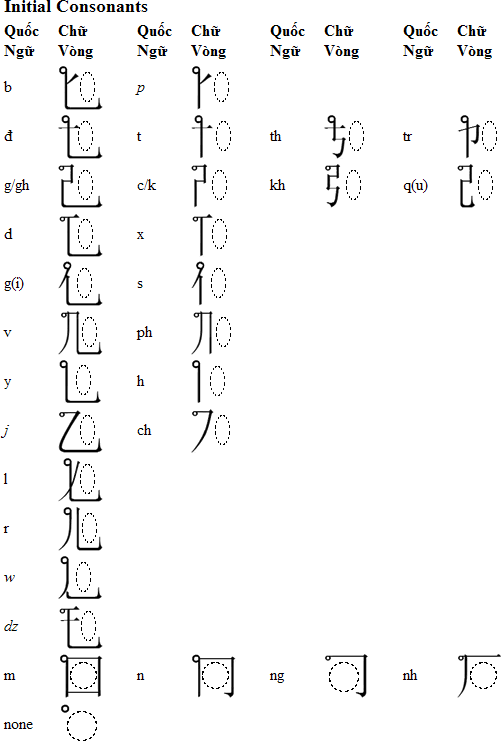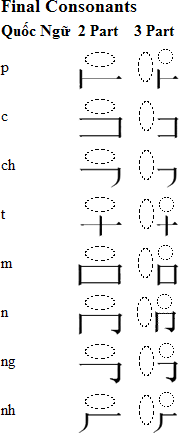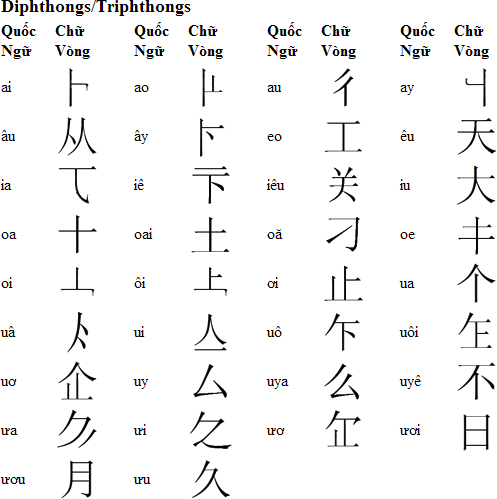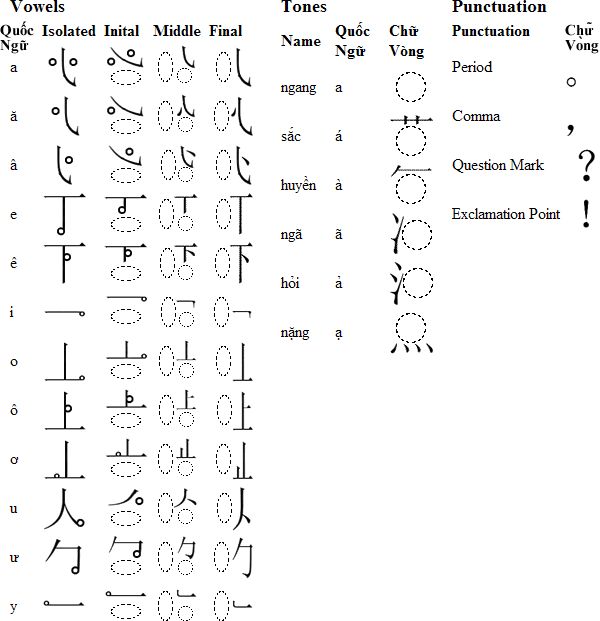Chữ Vòng 
Chữ Vòng, literally "circle script", is an alternative alphabet for Vietnamese invented by Albert Nguyen. The motivation to create Chữ Vòng came from the desire to mimic the ability of Korean and Japanese, which also once used Chinese as the sole writing system, to maintain the use of Chinese characters along with their own phonetic writing systems.
While Chữ Nôm is a good way to represent native Vietnamese words, it is cumbersome, takes years of study to master, and it has not been updated for modern Vietnamese. Quốc Ngữ is simple and flexible, but is not written in blocks and so does not support Chữ Nho (Chinese characters). Chữ Vòng provides a purely phonetic syllabic script that is flexible enough to import new words as necessary and is much easier to learn than Chữ Nôm.
While Chữ Nho and Chữ Nôm can be used along with Chữ Vòng, there are no set rules to determine which should be used and in what situations. Possible rules include:
Modern use of Chữ Nho and Chữ Nôm provides an opportunity to simplify characters as Simplified Chinese and Japanese have done. This would allow more characters to be used if one of the rules that consider stroke count is used.






(Article 1 of the Universal Declaration of Human Rights)

If you have any questions about Chữ Vòng, you can contact Albert at: albert.v.nguyen[at]gmail[dot]com
Information about Vietnamese | Chữ-nôm script | Phrases | Colours | Numbers |Family words | Tower of Babel | Learning materials
Other writing systems invented by visitors to this site
omniglot

Chữ Vòng, literally "circle script", is an alternative alphabet for Vietnamese invented by Albert Nguyen. The motivation to create Chữ Vòng came from the desire to mimic the ability of Korean and Japanese, which also once used Chinese as the sole writing system, to maintain the use of Chinese characters along with their own phonetic writing systems.
While Chữ Nôm is a good way to represent native Vietnamese words, it is cumbersome, takes years of study to master, and it has not been updated for modern Vietnamese. Quốc Ngữ is simple and flexible, but is not written in blocks and so does not support Chữ Nho (Chinese characters). Chữ Vòng provides a purely phonetic syllabic script that is flexible enough to import new words as necessary and is much easier to learn than Chữ Nôm.
Notable features
- Generally written from left to right, top to bottom. The traditional top to bottom, right to left pattern can still be used for artistic and ceremonial purposes.
- Each syllable block can consist of up to four parts, an initial consonant, a middle vowel or diphthong, a final consonant and tone mark. The only required component is a vowel.
- Chữ Vòng maintains constructions of Quốc Ngữ when not inconvenient. For example, while "tr" is closer to "ch" in sound, it is more similar to "t" when written.
- The nearly one-to-one relationship between Quốc Ngữ and Chữ Vòng letters (not including diphthongs) allows for easy transliteration from Quốc Ngữ to Chữ Vòng.
- Additional consonants allow importing words with phonemes not native to Vietnamese.
- Certain letters in Quốc Ngữ are pronounced differently depending on the regional accent, so the IPA pronunciation of the letters is not provided. Letters should be pronounced the same as their Quốc Ngữ equivalents.
- Diphthongs are constructed by combining component vowels and using an existing or modified character that resembles the combined vowels when possible.
- That Chữ Vòng is written in blocks allows the parallel use of Chữ Nho and Chữ Nôm.
While Chữ Nho and Chữ Nôm can be used along with Chữ Vòng, there are no set rules to determine which should be used and in what situations. Possible rules include:
- Always use Chữ Nho and Chữ Nôm when the needed character exists and only use Chữ Vòng when no character exists.
- Only use Chữ Nho and Chữ Nôm to write the top X frequently used words. (The sample below of the first two lines of Truyện Kiều uses this rule).
- Only use Chữ Nho and Chữ Nôm when the character requires fewer strokes than than when written in Chữ Vòng.
- Use all Chữ Nho characters and only use Chữ Nôm characters that require fewer strokes than when written in Chữ Vòng.
- A committee will determine a set of standard Chữ Nho and Chữ Nôm characters to be used, and all other words will be written in Chữ Vòng.
- Only use Chữ Nho and Chữ Nôm for names, decorative, and ceremonial uses.
- The entirity of Chữ Nho and Chữ Nôm may be used without rules, and the writer risks not being understood when using Chữ Nho and Chữ Nôm too aggressively.
Modern use of Chữ Nho and Chữ Nôm provides an opportunity to simplify characters as Simplified Chinese and Japanese have done. This would allow more characters to be used if one of the rules that consider stroke count is used.
Chữ Vòng writing system


Notes on consonants
- Italiced Quốc Ngữ letters indicate letters that are not native to Vietnamese, but are provided to import words as necessary.
- When transliterating words that start with "g(i)" or "q(u)", the "i" and "u" must be kept on the subsequent vowel or diphthong.
- The consonant variant of "y" is only used when followed by a vowel or diphthong. When "y" appears isolated or as an initial followed by a consonant, the vowel variant is used.
- The "none" consonant marker is used on isolated and initial diphthongs to indicate the word is written in Chữ Vòng and is not a Chữ Nho or Chữ Nôm character.

Notes on diphthongs
- Isolated and initial diphthongs should start with the "none" consonant marker to indicate a Chữ Vòng word instead of a Chữ Nho or Chữ Nôm character.
- Diphthongs should be resized in the same way individual vowels are resized when appearing as an initial, middle, or final letter.

Sample texts

Text in Quốc Ngữ

Translation
All human beings are born free and equal in dignity and rights. They are endowed with reason and conscience and should act towards one another in a spirit of brotherhood.(Article 1 of the Universal Declaration of Human Rights)

If you have any questions about Chữ Vòng, you can contact Albert at: albert.v.nguyen[at]gmail[dot]com
Information about Vietnamese | Chữ-nôm script | Phrases | Colours | Numbers |Family words | Tower of Babel | Learning materials
Scripts invented by Albert Nguyen
Chữ Vòng, TrantaneseOther writing systems invented by visitors to this site
omniglot



 Ngày khởi sự
Ngày khởi sự Đến từ
Đến từ Côngviệc / Sởthix
Côngviệc / Sởthix

